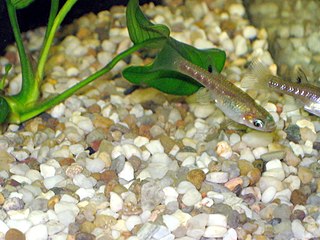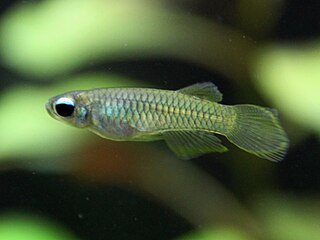The San Marcos gambusia is a likely extinct species of Gambusia from the family Poeciliidae that was found only in the San Marcos Springs of Central Texas. The fish has not been seen since 1983.
George Sprague Myers was an American ichthyologist who spent most of his career at Stanford University. He served as the editor of Stanford Ichthyological Bulletin as well as president of the American Society of Ichthyologists and Herpetologists. Myers was also head of the Division of Fishes at the United States National Museum, and held a position as an ichthyologist for the United States Fish and Wildlife Service. He was also an advisor in fisheries and ichthyology to the Brazilian Government.
The Lake Rukwa lampeye is a species of fish in the family Poeciliidae. Its natural habitats are intermittent rivers, freshwater marshes, and intermittent freshwater marshes. It is threatened by habitat loss. This species occurs in central Africa in Lake Rukwa, Tanzania, the Malagarasi River, Wembere River system and the upper basin of the Congo River. Its specific name honours the German physician and zoologist Friedrich Fülleborn (1866-1933), who collected the type.
The mesh-scaled topminnow is a species of fish in the family Poeciliidae. The two population groups are a southern group of populations found in Angola, Botswana, the Republic of the Congo, Malawi, Mozambique, and Zambia and a northern population group found in Chad, the Central African Republic, the White Nile in South Sudan and Sudan and in the northern Democratic Republic of Congo. Its natural habitat is small streams and brooks, lakes, and swamps on floodplains where it lives among aquatic vegetation. This species was described by George Albert Boulenger as Haplochilus hutereaui in 1913 with the type locality being Dungu on the upper Uelé River in the Democratic Republic of Congo. Boulenger received the type from Armand Hutereau (1875-1914), who was the head of a Belgian ethnographic expedition to the Congo, so he honoured Hutereau in the specific name.
The yellowfin gambusia is a species of fish in the family Poeciliidae. It is endemic to the Rio Conchos of Chihuahua, Mexico, where it is known as guayacon de san gregorio. This species was described in 1957 by Clark Hubbs and Victor G. Springer with the type locality given as El Ojo de San Gregorio in Chihuahua. The specific name of this fish honours the Mexican ichthyologist José Alvarez del Villar (1903-1986) for his work on the fishes of Mexico and for his assistance to Clark and Springer.
Valencia letourneuxi, the Corfu toothcarp, is a species of fish in the family Valenciidae. It is found in Albania and Greece. Its natural habitats are rivers, freshwater marshes, freshwater spring, and coastal saline lagoons. It is threatened by habitat loss. The specific name of this fish honours the collector of the type, the botanist Aristide-Horace Letourneux (1820-1890). The species was described as Fundulus letourneuxi in 1880 by Henri Émile Sauvage with a type locality of Cressida, Corfu. It also formerly occurred on the island of Lefkas but is now considered to be extirpated from both there and Corfu. Valencia letourneuxi is a highly endangered freshwater species that faces threats from habitat degradation, water abstraction, and foreign species. While little is known of its ecological history, V. Letourneuxi produce 2.2 mm eggs during the spring on aquatic plants in stagnant water that has a lot of vegetation.
The yellow swordtail is a species of freshwater fish in the family Poeciliidae. It is endemic to the upper Coatzacoalcos River basin in southern Mexico. It is typically found in brooks and streams with slow current; it is less frequent in areas with strong current. The yellow swordtail is considered a threatened species by Mexican authorities. It reaches up to 5.1 cm (2.0 in) in standard length.
The Chiapas swordtail or upland swordtail is a species of livebearing freshwater fish of family Poeciliidae, and genus Xiphophorus. It is, therefore, in the same genus as the common platy and the swordtail. The Chiapas swordtail was discovered and first described by Donn E. Rosen in 1960, along with four other species of Xiphophorus.

Alfaro is a genus of poeciliid fishes endemic to Central America. The generic name honours the Costa Rican archaeologist, geologist, ethnologist, zoologist and Director of the National Museum of Costa Rica, Anastasio Alfaro (1865-1951).

The pike topminnow, more commonly known as pike killifish and sometimes referred to as topminnow, is a species of poeciliid found from Mexico to Nicaragua. It has also been introduced to Florida, USA. It is the only known member of its genus. The pike topminnow was described in 1860 by Austrian ichthyologist Rudolf Kner, who gave the type locality as Belize, which is reflected in this species' specific name.
Carlhubbsia is a genus of poeciliids native to Guatemala and Mexico. The name of this genus honours the American ichthyologist Carl Leavitt Hubbs (1894-1979) who originally named the genus Allophallus, a name which was preoccupied by a genus of Diptera.

Girardinus is a genus of poeciliids native to Cuba. The name of this genus honours the French zoologist Charles Frédéric Girard (1822-1895) for his work on the freshwater fish of North America.

Xiphophorus nezahualcoyotl, the mountain swordtail, is a live bearing fish in the family Poeciliidae. It is endemic to the northwestern Pánuco River basin in Mexico. The specific name of this fish refers to the poet, philosopher and emperor of Texcoco, Nezahualcoyotl (1402-1472).
John Roxborough Norman was an English ichthyologist.
The Dead Sea toothcarp is a species of toothcarp in the family Aphaniidae that is endemic to the Dead Sea basin. It is threatened by water fluctuation, and the introduction of cichlids and Gambusia. The specific name of this fish honours the Scottish surgeon and naturalist John Richardson (naturalist) (1787-1865) who first reported killifish in the Dead Sea basin. The Dead Sea toothcarp has been on the Red List of the International Union for Conversation of Nature since 2006.

The Nile killifish, also known as the Nile lampeye, is a species of killifish from the family Poeciliidae. It is found in the White Nile drainage in Sudan, the Nile Delta in Egypt, the Wembere and Malagarasi Rivers in Tanzania and in the Lake Victoria basin in Uganda and Tanzania. However, it is thought to have been extirpated from Egypt, the introduction of alien poecilid fish, agricultural pollution and increasing salinity are all thought to have contributed to its local extinction in the Nile Delta.
Aapticheilichthys is a monotypic genus of killifish from the family Poeciliidae, the sole member being Aapticheilichthys websteri. A. websteri was found by the American fish breeder Kent Webster after which the species was named. The type locality was Akaka Camp on the western coastal plain of Gabon. A. websteri was collected from a river that was less than 10m wide on the night of the Asian tsunami, though it is not clear what effect of the tsunami may have had on the local ecosystem.
Alfaro huberi is a species of livebearer in the family Poeciliidae, in the New World subfamily Poeciliinae. It is found in clear, fast flowing streams in Central America where it has been recorded from Honduras, Guatemala and Nicaragua. This fish was formally described in 1923 as Priapichthys huberi by Henry Weed Fowler with the type locality given as Marceligo Creek which is a tributary of the Río Tunky at Miranda in Nicaragua. The specific name honours the Curator of Mammals at the Academy of Natural Sciences of Philadelphia Wharton Huber (1877-1942), a colleague of Fowlers, who collected the type.

Poropanchax normani, also known as the Norman's lampeye, is a species of Poeciliidae native to Africa.
Cnesterodon raddai, the Resistencia toothcarp, is a species of poeciliid native to the Paraguay and lower Paraná River basins.





